![]()
![]()
![]()
Use LEFT and RIGHT arrow keys to navigate between flashcards;
Use UP and DOWN arrow keys to flip the card;
H to show hint;
A reads text to speech;
20 Cards in this Set
- Front
- Back
- 3rd side (hint)
|
Agonist |
Does most of the work
|
|
|
|
Synergist |
Helps primary muscle (agonist) |
|
|
|
Antagonist |
Does opposite of agonist |
|
|
|
Fixator |
Agonist and antagonist that work together to stabilize a joint |
|
|
|
4 muscles of mastication |
Masseter temporalis medial pterygoid lateral pterygoid
|
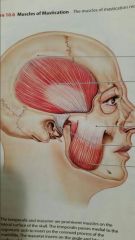
|
|
|
Actions of the following muscles: Masseter Temporalis Medial pterygoid Lateral pterygoid |
elevates mandible elevates mandible elevates mandible; moves it from side to side protracts mandible; moves it from side to side |
|
|
|
Action of the Sternocleido-mastoid muscle |
flexes the neck |
|
|
|
The erector spinae consists of 3 main muscles sets |
iliocostalis
longissimus
spinalis |
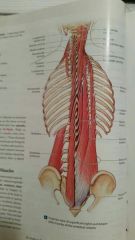
|
|
|
iliocostalis muscles (lateral) consist of 3 muscles. What are they and what are thier actions? |
Cervicis- extends neck Thoracis- stabilizes thoracic vertebrae in extension Lumborum- extends vertebrae; depresses ribs |
|
|
|
longissimus muscles (intermediate) consist of 3 muscles. What are they and what are thier actions? |
Capitis- extends neck Cervicis- extends neck Thoracis- extends vertebrae |
|
|
|
spinalis muscles (medial) consist of 2 muscles. What are they and what are thier actions? |
Cervicis- extends neck Thoracis- extends vertabrae |
|
|
|
Action of the quadratus lumorum |
depress ribs; stabilize diaphragm during inhalation |
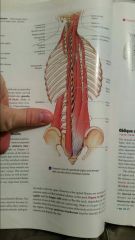
|
|
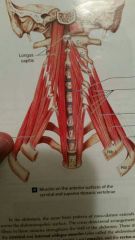
Action of scalene muscles |
elevates ribs; flexes the neck |
|
|
|
Action of external intercostals |
elevates ribs during INHALATION |
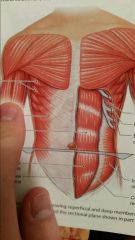
|
|
|
Action of internal intercostals |
depresses ribs during EXHALATION
|
|
|
|
Action of external obliques |
compresses abdomen; depresses ribs |
|
|
|
Action of internal obliques |
compresses abdomen; depresses ribs |
|
|
|
Action of tranversus abdominis |
compresses abdomen |
|
|
|
Action of rectus abdominis |
depresses ribs; compresses abdomen |
|
|
|
Action of diaphragm |
Contracts and expands thoracic cavity |
|

